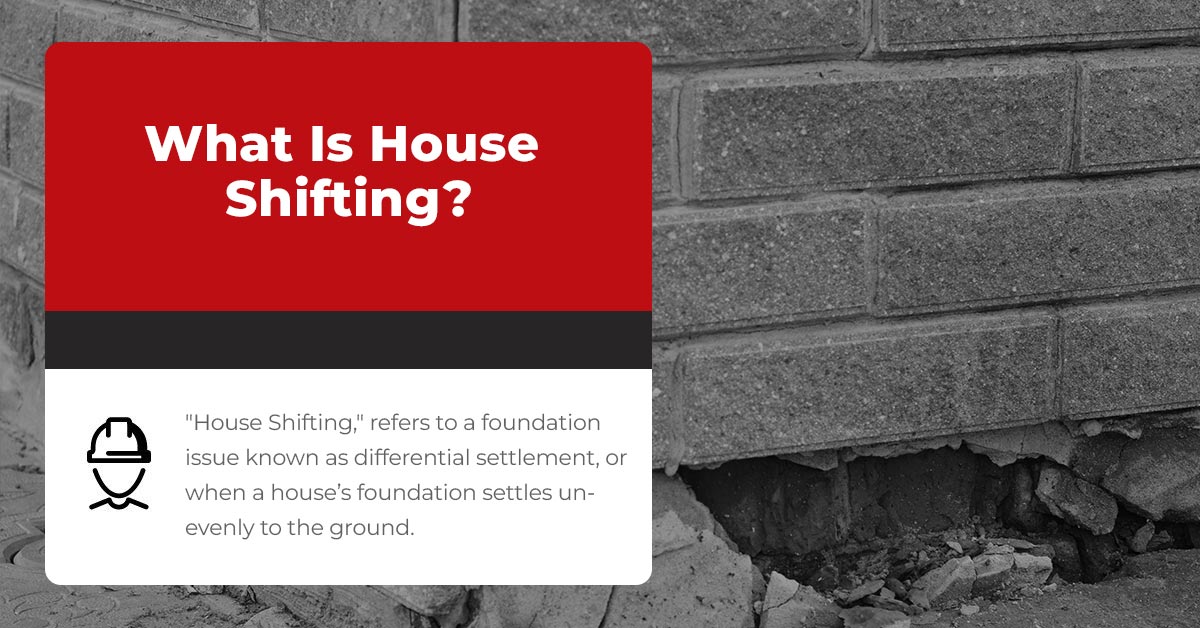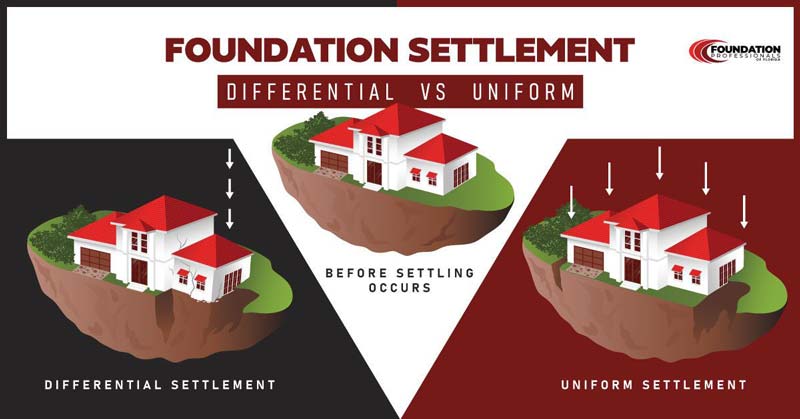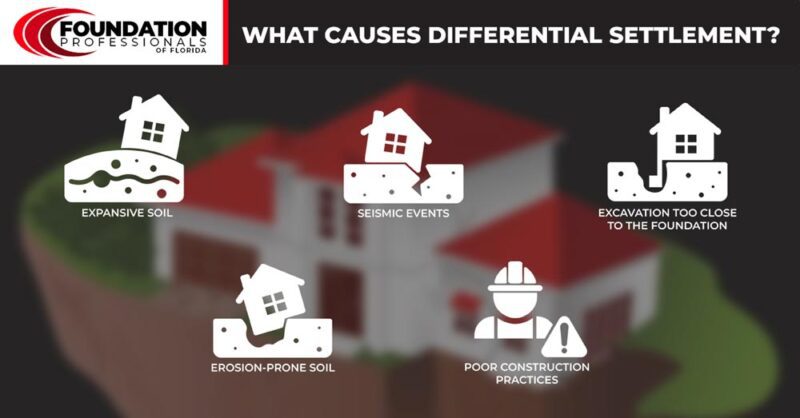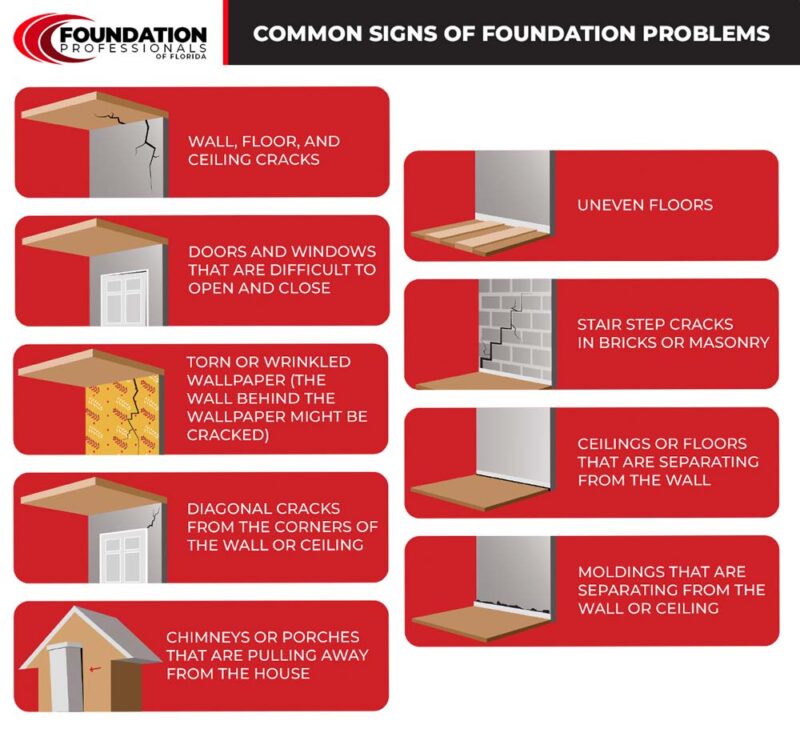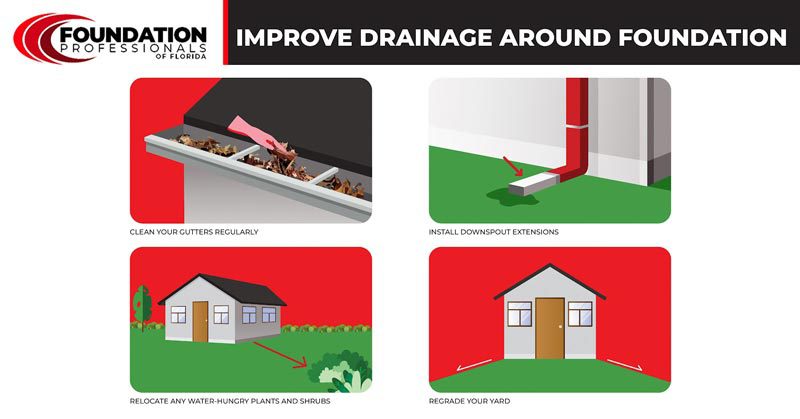Are you searching for information about house shifting? If so, you’ve landed on the right page because that’s what we’re going to talk about in this article. We’ll review what the term “house shifting” means, what causes a foundation to shift, common signs your house might be shifting, and more.
What Does The Term “House Shifting” Mean Exactly?
When we talk about “house shifting,” we are referring to a particular foundation issue known as differential settlement. This happens when a foundation settles into the ground unevenly. The best way to explain this is via an illustration:
As you can imagine, differential settlement places a lot of stress on a foundation and can cause severe structural damage if it isn’t corrected.
So, what causes differential settlement?
Differential settlement is caused by various things, including the following:
- Expansive soil – Expansive clay soils are a common cause of foundation problems. These soils contain a high percentage of clay minerals, which have the unique characteristic of swelling and shrinking with changes in moisture content. This means that when the soil becomes wet, it swells and then shrinks when it dries out. This can cause significant movement under a foundation, eventually leading to differential settlement.
- Erosion-prone soil – When the soil under a foundation erodes, voids form. If the foundation settles into these voids, it will result in differential settlement.
- Seismic events – This one probably doesn’t need much explanation. Differential settlement is likely to happen when the ground moves under a foundation.
- Excavation too close to the foundation – As excavation occurs, any undisturbed soil previously supporting the foundation may destabilize, causing the foundation to shift and settle unevenly.
- Poor construction practices – Soil compaction needs to be carried out before construction begins. This involves using heavy machinery, such as large rollers or compactors, to press down on the soil to remove voids or air pockets. If this isn’t done, the structure could settle unevenly into the ground after it’s built.
How Differential Settlement Differs From Uniform Settlement
There are two types of foundation settlement: uniform foundation settlement and differential foundation settlement.
Uniform foundation settlement
Uniform foundation settlement occurs when the entire foundation sinks at a uniform rate. This type of settlement is usually caused by natural adjustments in the soil beneath a heavy foundation. It’s pretty common and usually, nothing to worry about.
Differential foundation settlement
Differential foundation settlement, on the other hand, occurs when one area of the foundation settles at a faster rate than another area. As noted above, this can be caused by a variety of factors.
Signs Your Home May Be Experiencing Differential Settlement
The following are some common signs your house might be “shifting,” that is, experiencing differential foundation settlement:
- Cracks in the walls – These cracks may start small but can quickly grow larger. You may notice specific patterns of cracks, such as diagonal cracks or stair-step cracks in brick or masonry. These cracks can occur both inside and outside your home.
- Uneven floors – This doesn’t have to be an unevenness that’s immediately visible. It might be very slight.
- Sticking doors or windows – You may find that your doors or windows are difficult to open and close. This is because your home’s foundation has settled unevenly, causing the doors and windows to become misaligned. You may also notice gaps around doors and windows.
- Chimneys and porches separating from the house – These separations might be very slight. However, they shouldn’t be ignored.
- Torn wallpaper – The wall behind the wallpaper might be cracked.
- Moldings that are pulling away from the wall or ceiling – This can happen when things aren’t moving as one unit.
- Walls separating from ceiling or floor – This indicates the foundation has moved.
- Diagonal cracks – These often happen around windows and doors.
If you notice any of these signs in your home – or anything else that seems suspicious – contact a foundation repair contractor immediately. A foundation specialist can assess your home and offer the appropriate repair solution. Ignoring the problem can lead to further damage and even more costly repairs.
For more information, see Common Signs Of Foundation Issues In Residential Homes.
Repair Solutions For House Shifting
Fortunately, there are several repair solutions available for correcting differential settlement. These solutions include push piers, helical piers, drilled concrete piers, and slab piers.
Push piers
They are driven deep into the soil using hydraulic pressure and the weight of the house until they reach the load-bearing stratum. Once they’re in place, a synchronized hydraulic lifting system raises the foundation to maximum practical level, which means as much as possible without damaging the foundation.
Helical piers
Helical piers also work by transferring the structure’s weight to more stable ground, but they are installed by twisting them into the ground like a screw. Helical piers are often used on lightweight structures.
Drilled concrete piers
Drilled concrete piers are another commonly used method for correcting differential settlement. They are installed by drilling a hole into the ground and filling it with reinforced concrete, creating a column that supports the weight of the building. This method is effective in restoring the foundation of a structure but can be significantly more expensive than other solutions, such as helical piers and push piers.
Slab piers
Slab piers are push or helical piers installed through a concrete slab and down to the load-bearing soil below.
How To Help Prevent House Shifting
Fortunately, there are certain steps homeowners can take to help prevent foundation problems from occurring:
Regrade the yard if necessary so it slopes away from the foundation
If the ground around the house slopes toward the foundation, water will accumulate in the soil and cause trouble. It might seep in through a cracked foundation wall, for example. The excess moisture in the ground could also cause hydrostatic pressure to build up and push against foundation walls, leading to severe structural damage.
Regrading the yard so that it slopes away from the foundation will help keep water away from the foundation. Professional help may be required for major regrading work.
Clean gutters regularly
Clogged gutters can cause water to overflow the side of the house and collect around the foundation. Cleaning gutters regularly will ensure water is directed toward the downspouts and away from the foundation.
Install downspout extensions
Downspouts that discharge water right next to the foundation do more harm than good. Downspout extensions should direct water at least 6 feet from the foundation before release.
Keep trees away from the foundation
Large tree roots can cause all sorts of problems for a foundation, including “drinking” water from the soil around the foundation, leading to the formation of voids and then differential settlement. Trees should be at least 15 feet away from the house.
Install a drain tile system
If you live in an area with heavy rainfall, installing a drain tile system can help protect your foundation. A drain tile system is installed around the perimeter of the foundation and redirects water away from the foundation into a drainage system. A drain tile system comprises perforated pipes, gravel, and filter cloth.
Foundation problems can be costly and time-consuming to fix. However, with regular maintenance and the measures mentioned here, homeowners can help prevent trouble.
If you think your house might be shifting, contact us today to schedule a foundation evaluation. If we find a problem, we’ll give you a repair estimate.

